The Gable Legacy
Presented at the 1976 Annual Meeting of the American Rhododendron Society
by George W. Ring III, Fairfax, Virginia
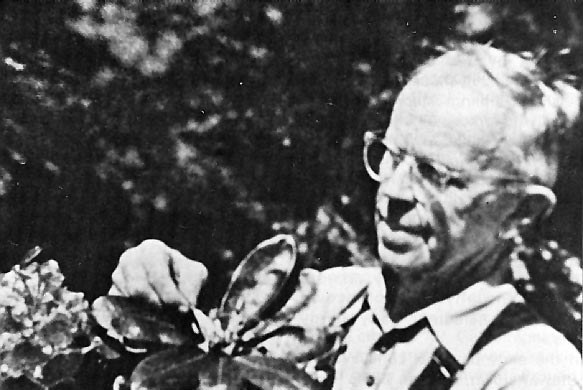
|
| Joseph B. Gable |
This evening I want to tell you about the late Joseph B. Gable and his rhododendron hybridizing. Some years ago Mr. Gable gave a talk in New York on nut tree hybridizing, and in beginning said, "I know very little about nut trees and it would probably be better if I should keep my mouth shut and let you folks think I knew nothing, than to open my mouth and remove all doubt from your minds." He then proceeded to present a very thought provoking talk on nut tree hybridizing and on plant breeding in general. One quote especially worth mentioning was, "Life at best is uncertain in length, and, while the individual may be very capable and, starting, accomplish something quite worthwhile, he will be fortunate indeed if those who follow keep up the work." This was in 1936 when Mr. Gable was only 50. He lived to be 86.
There are many people, here in the audience and some not able to be here, who have known Mr. Gable and his plants better than I. There's Dave Leach, Charlie Herbert, John Wister, Guy Nearing and many others. It is indeed a privilege to be asked to make this talk. The main intent this evening is to give you a report on the work of the Gable Study Group. I will also try to tell you about Mr. Gable as an extraordinary man, and finally, show some slides, with appropriate documentary, of many of his hybrid rhododendrons, and the species he selected for hardiness at his home in Stewartstown, Pennsylvania.
Encouraged and ignited by a talk given to the Potomac Valley Chapter by Captain Dick Steele, an old friend and admirer of Mr. Gable, the chapter formed a Gable Study Group in 1973 to research and document Mr. Gable's work, from his notes and correspondence, and to catalog the known Gable plants. The original committee, in addition to myself, included Caroline Gable, George Miller, and Jane and Ray Goodrich. We were later joined by Russ and Velma Haag from North Carolina, long time admirer's and collectors of Gable plants.
In 1973, the Study Group developed a preliminary list of known Gable rhododendron hybrids and selected species and sent it to people known to have Gable plants with a request for them to identify those Gable plants in their gardens and to provide us with additional data they might have. In response, we received some forty replies from growers and collectors. Many of the replies included ratings, comments, and lists of other Gable plants we didn't know existed. It is difficult to begin thanking all those who sent in replies, but we are very grateful to the Haags and to many members in Pennsylvania, including Dr. John Wister, Dr. Frank West and Charlie Herbert, among others. In addition, Dr. West, Dr. Tom Wheeldon of Richmond, Va., and George S. Lee of Connecticut were particularly helpful with the Gable azaleas. When all the information was collated, over 100 named rhododendron hybrids were identified, over 90 more, mostly group crosses, described by their parentage, and more than 50 species were listed which has been obtained from Mr. Gable. This information has been complied into a 33-page pamphlet which was distributed to each contributor. In addition to rhododendron names, the listing contains parentage, flower color, blooming period, hardiness, and ratings where this information was available.
A separate listing of evergreen azaleas includes 30 named varieties Mr. Gable selected as his best, and more than 200 others, some numbered by Mr. Gable, and some named and propagated by others.
All of this material has been provided to Dr. Franklin West, Editor for a forthcoming book on Eastern rhododendron hybridizers. I would like to tell you a little about the man who created all of these outstanding plants. Since this is the year of America's Bicentennial Celebration, it is only fitting to mention that Mr. Gable's German ancestor is supposed to have arrived here as a Hessian Mercenary in 1776, later settling in York County, Pennsylvania. The family was noted for its eccentricity, since Joe's grandfather paid carpenters rather than furnish whiskey for a barn raising, and allowed his home to be used at least occasionally as a stop on the underground railroad. Joe was impressed by the rejection by both his grandfather and his father of the customary practice of planting by the phases of the moon. At an early age, Joe developed a pattern of roaming the woods that was to be lifelong. Like his father, he took a great interest in the wonders of nature, and looked closely at everything about him. He loved to hunt, and his woodsmanship was such that his fellow gun club members called him "Daniel Boone". As he grew up, Joe thought he wanted to be a surveyor, but was instead sent to school to become a teacher. Near the end of his first year, his college math instructor gave him a failing grade for going to play ball instead of completing an exam (which he passed by correctly answering 7 of the 10, problems). As a result, Joe left school and eventually settled down to becoming a farmer. However, in 1918, nearly 30 years old, he was drafted into military service and went to Europe as a bass horn player in the 329th Field Artillery Band. Long afterward, Joe remembered the rhododendrons he had seen from a troop train crossing England as the beginning of his serious infatuation.
On returning home to Stewartstown, Pennsylvania, he married Mary Belle Dalton, his lifelong love, and settled down to raising a family, apples and general farming. The house eventually became filled with children, and somehow, in the middle of these busy and hardworking farm years, Joe Gable decided to become a nurseryman.
Now Stewartstown is located about 40 mites North of Baltimore, Maryland, just into Pennsylvania, and is a small town by any measure. Recently, a young medical student, going to see Mr. Gables' place for the first time, stopped at a tourist information booth near Philadelphia to ask directions to Stewartstown. The young lady attending the booth replied - "Stewartstown? - That's a new one on me."
Regardless of its size, the climate at Stewartstown can be severe, and temperatures have been recorded as high as 107'F, and as low as -21 'F. The soil there is fairly well drained, and has good acidity for rhododendron plantings. In "Little Woods" itself, where the rhododendrons grow under the high shade of oaks, the subsoil abounds with quartz fragments.
In beginning his nursery, Joe characteristically began by reading, and then writing to wherever he thought he might get access to more reading material. He even dared to send bundles of collected native Azaleas to Dr. Charles Sargent at the Arnold Arboretum, asking whether he had discovered something new. Back came the patient answers, "all nudiflorum." But with the answers came publications, seed, and information about the early plant explorers.
Eventually, the first price list of the Gable Nursery, dated 1926, was ready, the familiar single page, folded in 'thirds' for a letter envelope. The list was long, with many evergreens besides rhododendrons and deciduous azaleas, and his notation, "if you ask for what you want, perhaps I have it."
Correspondence began to flow, with George Fraser and James Barto in the Pacific Northwest, and with J. P. Magur, R. Gill and Sons, and R. L. Nottcut in England. By 1929, he was growing seedlings from several plant hunting expeditions, and his records indicate more than 100 Rhododendron species and another 100 hybrids growing at Stewartstown. All of this, working alone, without plastic bags, knowledge of growing seedlings, in sphagnum, airplanes to carry plant material, and refrigeration to store pollen. When pollen arrived from England, it was immediately used on whatever was in bloom. Perhaps this is why we have his beautiful
R. maximum
x
R. haematodes
hybrids today, and the cream colored 'Catalgla' x
R. wardii
.
About this time, Joe Gable and Guy Nearing met and began an exchange of letters, plant material and enthusiasm that was to last 40 years. They had a common bond of enchantment with the lepidotes and soon produced "Conewago", 'Windbeam' and many others which give faithful annual performances in thousands of American gardens. Joe and Guy combined hundreds of exotic tender types with the ironclads in the hope that they would get hybrids both exotic and hardy. As a result, thousands of undistinguished seedlings bloomed, but occasionally it worked. A classic example is Joe's 'Mary Belle' in which he combined
R. decorum
x
R. haematodes
with Atrosanguineum' x
R. griersonianum
.
In later years, Henry Yates of Frostburg, Maryland became a fast hunting friend and raised many seedlings of Gable crosses which they shared. Henry eventually made his own crosses and selected many hardy clones.
In the early days at 'Little Woods' in Stewartstown, as the Gable seedlings matured, each spring became a season of excitement to see surviving seedlings bloom. For the rest of this presentation I will show slides of some of the Gable plants.
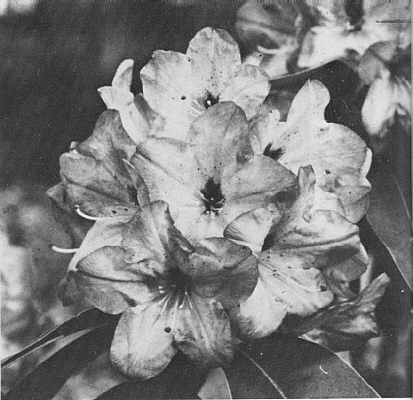
|
| R. 'David Gable' is an early bloomer. |
First, the most widely grown clones. 'Caroline' is white, edged mauve. Reported to be very root rot resistant, its progeny include 'Cadis' and the reverse cross 'Discs'. 'David Gable' is 'Atrosanguineum x
R. fortunei
'. It blooms early. 'County of York'. Katharine Dalton'. 'Annie Dalton'. 'Pioneer' is probably the widest grown of the scalies. It is a seedling of
R. mucronulatum
, probably pollinated by
R. racemosum
.
There was a bit of confusion about 'Conestoga',
R. carolinianum
x
R. racemosum
, Rock 59717. Mr. Gable's notes say that it apparently dies out in 5 to 10 years, both for him and his customers. "I do not know of a single living plant of true 'Conestoga'."(1954). Therefore we assume that the respondents who said they have 'Conestoga' probably have 'Conestoga, Improved', a seedling which was also propagated. 'Mayflower' is a little known second generation seedling.
'Conewago' is
R. carolinianum
x
R. mucronulatum
. 'Conewago Improved' has better flowers and foliage and does not break so easily under snow loads. There is also 'Conewago Special' and 'Conewago #2', the latter having lighter colored flowers. A seedling of '#2' is 'Conewago #3' with larger flowers and lighter coloring. The 'Conewago' tribe often escapes late frosts in this area while 'Pioneer' may not.
The 'Keisrac' group varies from pale pink to pale yellow to almost white. Nearing finally got one of these to take
R. keiskei
pollen and the result was 'Mary Fleming'.
R carolinianum alba compactum
is dense growing and has short annual growth. Another good one is called Bowman's
carolinianum alba
. 'Carolio' is a cross of
R. carolinianum
x
R. oleifolium
x
R. davidsonianum
. And there is also the more typical
R. carolinianum
. Gables'
R. augustinii
blooms in late April. 'Mucram' is also early, as is 'Conemaugh' and
R. keiskei
. These last four are all good early bloomers, but you do take a chance that they might be caught by an April frost.
R. racemosum
is later and safer. Gables' notes indicate that his stock grown from seeds were hybrids of the two varieties of
R. racemosum
, Forest 19404 and Rock 59717, the latter being by far the hardiest of the two.
To Mr. Gable we are indebted for a hardy strain of
R. fortunei
. He grew a great number in the woods, the weaker perishing in harsh winters. Seed was saved from the survivors, shared with Guy Nearing, and the two evolved through the years a strain which will stand -15° F. These pale mauve to almost white hardy species were parents of the Madforts. The seed parent, 'Madonna' was
R. decorum
x
R. griersonianum
x R. 'America'. It has a large white trumpet-shaped flower. Unfortunately, 'Madonna' is difficult to root, and we found only three surviving clones of this plant in the survey. But crossed with
R. fortunei
, it produced 'Yelton's Choice', 'Big Bells', 'Bellfort', 'Hardy Madfort' and 'White Lily'. Many of the Madforts were sold by Mr. Gable, and the recipients regarded them as so superior that they made cuttings and sent them back to Stewartstown...almost always with the notation, "you sold me the best one, and surely a cutting should be growing in your woods."
Among the many species Gable grew in those woods is
R. houlstonii
. It blooms early and sometimes gets caught by late frosts, but it's well worth the gamble.
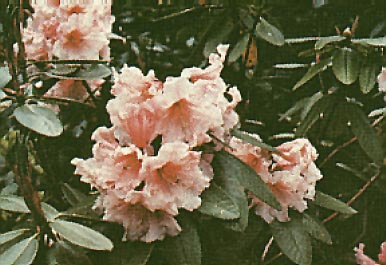
|
|
R. 'Dr. Rock'
Photo by George Ring |
Another outstanding species is
R. vernicosum
, aff., Rock 18139. These were grown from seed of the 1929 Joseph Rock expedition to China. It took years for them to bloom from seed. From cuttings they are not so slow. Gable propagated the best two. Clone #1 is the more peach colored of the two, and clone #2 is the pinker of the two. This
R. vernicosum
aff. was a good parent. Crossed with
R. houlstonii
, it gave 'Dr. Rock'. With 'Mary Belle' as the seed parent, we have 'Isabel Gable'. Isabel is coral in bud, opens to flesh pink, and is hardy to -10°F.
R. vernicosum
, aff. crossed with
R. fortunei
, cream resulted in 'Mary Garrison' a salmon yellow with blends of brownish red colors. 'Mary Garrison' has been difficult to root in the past. Another hybrid is
R. brachycarpum
x
R. vernicosum
aff. Rock 18139.
Now we come to the 'Catagla' x
R. wardii
crosses. Mr. Gable repeated this cross many times, always seeking a good hardy yellow hybrid. Progeny of his first cross tend to be early season bloomers. 'Moonshot' is the best known of these. There are also 'Catwardii #1' and 'Cat-wardii #2'(2-66). 'Cat-wardii #2' usually blooms an ivory-yellow with green spots, but depending on the weather it can look pale pinkish cream. From a later Catwardii cross came 'Joe Gable', perhaps the best of these. 'Henry Yates' may also belong in this group, however there is some indication that it is a
R. litiense
hybrid.
'Catalgla', which is a shortened farm of
R. catawbiense album
, Glass, came from seed of a white form of
R. catawbiense
found by Powell Glass in the mountains of Virginia. Here was the hardy element for rhododendron hybrids without the magenta tint of the ordinary
R. catawbiense
. Gable used it extensively as a parent. He also sowed seed from his 'Catalgla', and when some customers observed that their plants bloomed lavender, he withdrew the item from his listings, and all the customers had a white
R. catawbiense
refunded to them! He said, as a way of explanation, "You can't tell what those bees will do." We surmise that after hand pollinating, the stigma was still receptive when the bees came around with pollen from a neighboring
R. catawbiense
in the woods.
The cross which gave 'Pink Twins' was from a red flowered
R. catawbiense
and an
R. haematodes
from the Arnold Arboretum. Many people reported to us that "Joe always told me his
R. haematodes
was a hybrid," and so it may have been, this one from the Arnold Arboretum. But, he also used pollen from another form of
R. haematodes
; this from Magor in England, which he regarded as more typical of the species. The pollen from Magor was used to develop the Maxhaems; '#7' is salmon, '#10' is yellow, and there is also a clear red. The Maxhaems are fairly small flowered, but have excellent foliage, and some are very hardy.
A sibling of 'Pink Twins', called 'Cathaem #1' was an important parent for Mr. Gable. He crossed this with 'Mars' several times. He is quoted as saying of 'Mars' hybrids, "some are tender, some are awful, but the remainder are magnificent. The Marcats, as they are called, include 'Frazzles', 'Red Sox' (a hose-in-hose red), 'Marcat 4', 'Marcat 58' and 'Tom Thumb', a dwarf red. 'Tom Thumb', selfed, produced the Tommies. In researching the Tommies, a member of the Study Group questioned whether 'Tom Thumb' was indeed the parent, since all of the Tommies were all of good stature, with none of the dwarf characteristics of 'Tom Thumb'. The explanation did not lie in a hereditary fluke. It was much more simple. Gable had all the dwarf seedlings line up together, and they were all "lifted." The Tommies are numbered 1 through 12. 'No. 2' is a bi-color. 'No. 3' is called 'Plain Pink'. Flower color of the Tommies is good and clear. Even on a grey day they look bright. Two unnumbered Tommies are called 'Bonnie' and 'Little Bonnie', Buff colored like the collie dog after which they were named. 'Mary Yates' is a Tommy named by Henry Yates, and his 'Shazaam' may also be a Tommy since the seed was shared.
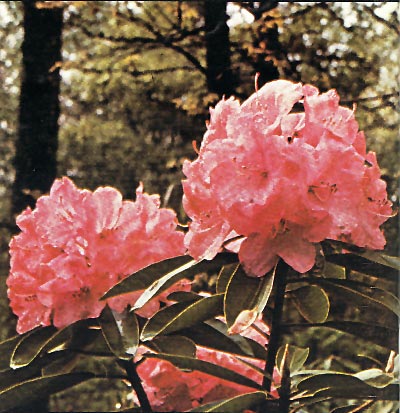
|
|
R. 'Plain Pink'
a Joseph Gable hybrid |
'Mars' was also used with 'Catalgla' to produce some superlative plants. This cross was made with Henry Yates' help. Perhaps the best seedling is 'Running Deer' which is bright pink with a white throat. 'Dr. Bess' is a vigorous growing dusty rose that also blooms late midseason. 'Strawhat' is a glowing pink bicolor with green and white markings. It was so named because its truss fills a strawhat. Many of the Catalgla-Mars group are bi-colors as are some of the Tommies. 'Mars' seems to be the influence for the bicolor.
Another parent used extensively by Mr. Gable was the old
R. catawbiense
hybrid, 'Atrosanguineum', a hardy red. Crossed with
R. griersonianum
, it produced the Atrier group. 'Redhead' is Atrier #10. Gable wrote that the cross was originally planned only as a stepping stone for later crosses, and he was pleasantly surprised to find hardy plants surviving in his woods. Of course, about 90% did prove to be tender, but the survivors were considered hardy enough to propagate. Besides 'Redhead' there is also 'Atrier Hardy', 'Atrier Oak', 'Atrier No. 7' which could be the same as Henry's 'Redhead', and lastly, 'William Montgomery' which was the tenderest of the group and had the largest flowers. The Atriers range in color from rose-red to red, and vary in hardiness from -5° to -10°F. One of the Atriers, when crossed with
R. decorum
x
R. haematodes
produced 'Mary Belle'. From the same cross came 'Shrimp' and 'Flamingo', a bright salmon pink.
Now we come to 'Atroflo' which is recorded as 'Atrosanguineum' x
R. floccigerum
, Rock 18469. This
R. floccigerum
was in the "almost hardy" category, so Gable kept it in a tub which was moved into the barn each winter. 'Atroflo #2' is the hardier clone. The clone of 'Atroflo' which received the A. E. (Award of Excellence) is a bit more tender. Foliage of 'Atroflo' is dark green with suede like indumentum on the underside. The Study Group has hypothesized that the cross might have been
R. smirnowii
x
R. floccigerum
because of this heavy indumentum and other plant characteristics. The cross has been repeated this year on 'Atrosarrguineum' with pollen of
R. floccigerum
from the West Coast, although pollen of the original rock form of
R. floccigerum
would have been preferred, if available. Seedlings will be grown on and results reported later.
As mentioned earlier, Gable used his white 'Catalgla' extensively as a parent to impart clear color and hardiness. Crossed with
R. decorum
he produced 'Anne Glass'. The large white flat trusses are surrounded by a collar of good green foliage. Crossed with 'Madonna', came 'Lisa' and Lisa siblings. 'Mary K' is 'Catalgla' x
R. fortunei
In the Gable woods were other selected forms of
R. catawbiense
, 'Red Cat' among them, and there was also a good rose he used extensively. An early cross of one of these with
R. fortunei
produced the clone C-11,. This isn't around much, but it showed up in this year's truss show and won a ribbon! We believe that 'C-11' was the Catfort used as a parent for the plants known as Catfortcampys,
R. campylocarpum
being the pollen parent. There are only three selections, 'Salmon Bamboo' which is more coral than the slide shows, rated 4/2, 'Catfortcampy #2' (same as 6-62) which is apricot pink, rated 4/4. This is difficult to distinguish from the next one except for the foliage, 'Duponts Apricot' (also 2860) is a pale apricot. It was so named because Mr. Henri du Pont wanted to buy the plant, but Joe wouldn't sell it to him.
Mr. Gable seeded the species
R. decorum
14 different times. He liked the Forrest 30887 group very much, but the flower buds lost out in severe winters. There is a hardy
R. decorum
growing in the Gable woods today from one of the early seedlings. In the survey, Ross Davis of Wayne, Pa. and George Harding of Germantown, Md. both reported to be growing hardy
R. decorum
they bought as seedlings from Gable.
R. discolor
proved to be a good parent for Gable. For instance, 'Cadis', which we have already seen, and its sibling, 'Robert Allison' are two of the
R. discolor
progeny. The reverse cross,
R. discolor
x 'Caroline', was named 'Discs' which he regarded highly. In his notes, he commented that 'Discs' might be but a superior form of
R. discolor
itself. 'Discs' has been hand pollinated and the seedlings are well over knee high. When enough have bloomed, results will be reported.
There are a number of clones which are regarded as Gable-Nearings. The two men shared seed and plants so frequently that it is often difficult to determine who made the cross. 'Gretchen' is `Degriff' x 'Kettledrum'. Nearing made the cross and shared seed with Gable. Nearing's 'Rochelle' is a sister seedling.
Nearing's Pink, 'Degriff' x
R. williamsianum
x
R. auklandii
, growing in Gable's yard was from Nearing, and Gable wrote in 1956 that he regarded it as the finest of this group of hybrids.
Nearing's 'Catanea' was originally from Gable, whether a sister seedling of 'Catalgla', or a second generation, we don't know. And both 'Ramapo' and 'Purple Gem' were from a Gable cross and seed shared with Nearing.
There are a few clones believed by some to be Gable's hybridizations, which they are not. 'Pygmalion' x
R. haematodes
was a Dexter cross and he sent Gable a plant, which Gable thought well of. A named Dexter clone from this group is 'Dorothy Russell'. Despite many disclaimers which may be forthcoming, we accept this as a matter of fact, for it was so recorded in Gable's notebooks. Also, 'Russautinii' is not a Gable, but a gift from the Haags. It is an English cross.
There are other Gable clones rated highly by respondents to the survey. 'Milo' blooms fairly early, a handsome plant with pink and cream blends. 'Bosutch' is very early, before mid-April in this area. It has good dark foliage, although the flowers are not of the caliber of the Gable midseason hybrids. 'Pink Bosutch' is a sister seedling and blooms about a week later. 'Albert Close' blooms late and is hardy to 20°F. 'Mac Kantruss' is 'Degram' x 'Atrier' and blooms midseason. Its flowers hold up well in the heat. 14-59 and 15-59 are 'Annie Dalton' hybrids. The latter (15-59) is a low grower.
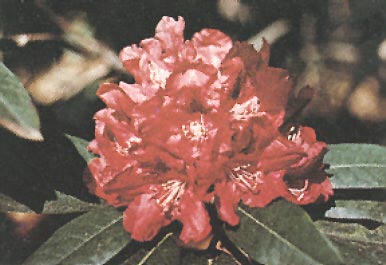
|
| R. 'Blackie' |
'Blackie' blooms late midseason, and is considered superior to its better known sibling, 'Kentucky Cardinal' which sometimes tends to brown an the edges of the flowers. 'Blackie' has a delicious fragrance of raspberries. Another clone, 1-67, is called 'Renaissance', was rated 4/3 and is hardy to -15°F. 'SmirFort' and 'Carol's Superwhite' are both large flowered plants and quite hardy.
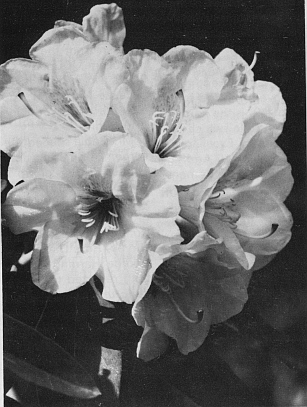
|
| R. 'Beaufort', a beautiful Gable hybrid. |
Although 'Beaufort' is reported by some to be a shy bloomer, it puts on a real show when given more sun.
Some unusual forms of species grown by Gable include a form of a
R. campanulatum
, a pinkish white variant with heavy indumentum, blooming very early. Another is
R. brachycarpum
, Notticutt, a free bloomer which may be a hybrid despite its typical
R. brachycarpum
foliage, and a white
R. vernicosum
, both of these are fragrant and early. This last was grown from a different seed lot than the Rock
R. vernicosum
, aff.
These are just a few pictures and descriptions of the rhododendrons and azalea legacy left to us by Joseph Gable. There are still many seedlings in "Little Woods" yet to bloom and be evaluated. Some are already showing promise, with tentative names such as 'Upper Right', a late discolor hybrid with a huge bicolor truss. And a 'Mary Belle' hybrid, a good yellow with an excellent plant habit. 'Annie '70' is a brilliant pink 'Annie Dalton' hybrid which promises to be a real winner.
As important as these new hybrids is the extremely valuable collection of selected hardy species such as a yellow
R. brachycarpum
, a hardy
R. decorum
, a hardy
R. campanulatum
, a
R. racemosum
hardy to -15°F, an
R. adenopodum
for early bloom, a red
R. catawbiense
, a red
R. maximum
, the
R. vernicosum
, aff. Rock 18139, and many others. The gene pool of hardy species and selected hybrids at "Little Woods" is unique, and recognized by hybridizers as a solid base for the future. To quote from a talk by Mr. Gable, "We are sure to realize sooner or later that creation is not yet complete."